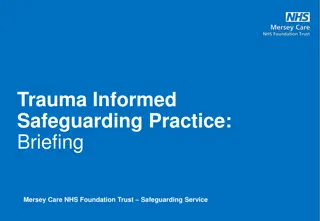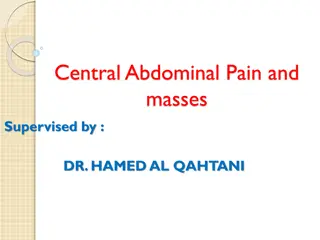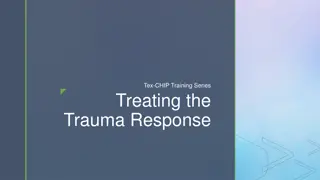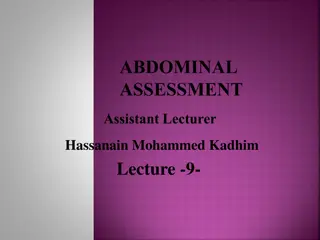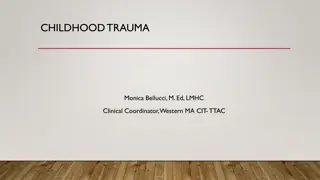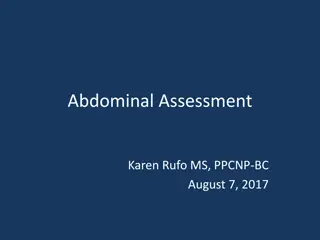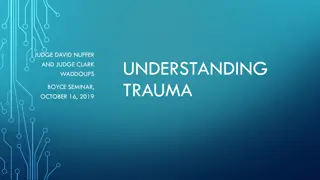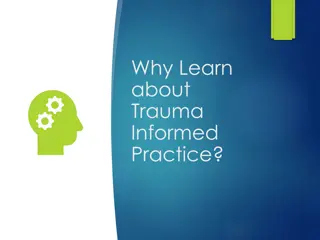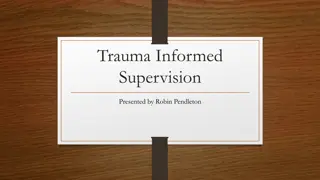Managing Abdominal Trauma: Early Identification and Assessment
"Abdominal trauma, particularly solid organ injuries like spleen and liver damage, requires swift and accurate assessment to prevent morbidity and mortality. This includes initial surveys, abdominal assessments, and imaging techniques like CT scans. Learn about the challenges, techniques, and importance of timely identification in treating abdominal trauma."
Download Presentation

Please find below an Image/Link to download the presentation.
The content on the website is provided AS IS for your information and personal use only. It may not be sold, licensed, or shared on other websites without obtaining consent from the author.If you encounter any issues during the download, it is possible that the publisher has removed the file from their server.
You are allowed to download the files provided on this website for personal or commercial use, subject to the condition that they are used lawfully. All files are the property of their respective owners.
The content on the website is provided AS IS for your information and personal use only. It may not be sold, licensed, or shared on other websites without obtaining consent from the author.
E N D
Presentation Transcript
Abdominal Trauma Thamer Nouh MD, FRCSC, FACS Associate professor & Consultant Trauma Surgery & Critical Care Medicine King Saud University
Introduction Solid organ injury is a leading cause of significant morbidity and mortality following injury. Identification of serious solid organ injury may be challenging. Many injuries, however, manifest during the initial assessment and treatment period. Thus, early identification is essential.
Initial Assessment and Resuscitation Primary Survey: Identification and treatment of life threatening injuries. Airway with cervical spine precautions Breathing Circulation Disability Exposure
Abdominal assessment Vital signs and physical exam Investigational Studies - FAST - DPA/DPL - CT Abdomen/Pelvis
Focused Assessment with Sonography in Trauma (FAST) First used in 1996 Rapid Sensitivity 86-99% May be able to detect as little as 100 ml of blood Cost effective Views: Pericardiac, perihepatic, perisplenic, and peripelvic spaces. User dependent with inherent limitations of ultrasound. Useful in unstable patient
CT Scan Gold standard. Hemodynamically normal patients! Provides excellent imagining of solid organs (liver and spleen). Determines the source and amount of bleeding (angio phase). Reveals associated injuries: pancreas, genitourinary. Poor for hollow viscous injury.
Solid Organ Injuries Difficult to diagnose on physical exam May lead to significant blood loss Grading of solid organs dependent on degree of hematoma, laceration, or avulsion. Injuries may present late, leading to further difficulty in assessment and management. The most common solid organs injured spleen and liver.
Key Principles Hemodynamically unstable patients require immediate laparotomy. - Splenectomy Non-operative management is an option in the hemodynamically stable patient ONLY. No patient should die as a consequence of non-operative management.
Non Operative management Intensive monitoring Serial clinical exam, Hgb level. High grade injury patients may require angiography +/- angioembolization to improve success rates. Patients are told to avoid contact sports for a period of time ( up to 7 weeks). If the patient becomes hemodynamically unstable, or requires multiple transfusions, then this is considered failure. Failure of NOM laparotomy and splenectomy.
Complications of NOM Failure! Splenic ischemia, infection, abscess. Chronic pain
Liver injuries Classification grade I haematoma: subcapsular, <10% surface area laceration: capsular tear, <1 cm parenchymal depth grade II haematoma: subcapsular, 10-50% surface area haematoma: intraparenchymal <10 cm diameter laceration: capsular tear 1-3 cm parenchymal depth, <10 cm length grade III haematoma: subcapsular, >50% surface area of ruptured subcapsular or parenchymal haematoma haematoma: intraparenchymal >10 cm or expanding laceration: capsular tear >3 cm parenchymal depth grade IV laceration: parenchymal disruption involving 25-75% hepatic lobe or involves 1-3 Couinaud segments grade V laceration: parenchymal disruption involving >75% of hepatic lobe or involves >3 Couinaud segments (within one lobe) vascular: juxtahepatic venous injuries (retrohepatic vena cava / central major hepatic veins) grade VI vascular: hepatic avulsion N.b. advance one grade for multiple injuries up to grade III.
Liver Injuries Similarly, regardless of grade, a trial of non-operative management is appropriate for stable patients. Unstable patients laparotomy - packing. - packing + angio. - deep liver sutures. - balloon tamponade. - hemostatic agents. - hepatic artery ligation.
Liver Injuries Laparotomy for continued blood loss with hypotension, tachycardia, decrease urine output, and decreasing HCT. Operative rate: - 3-11% with multiple injuries - 0-3% when isolated
Biliary Tree Injury 4% incidence of continued bile leak. Increased 10 fold in Grade IV and V injuries. ERCP with decompression and stenting may be both diagnostic and therapeutic. May require operative washout for delayed bile leak and peritonitis.
Other Complications Failure! Liver ischemia, infection, abscess Biliary leak, biloma, peritonitis.
Bowel Injury 1. Blunt 2. Penetrating: Stab, Gunshot 3. Operative
Mechanism Crushing: Compression Shearing: Sudden Deceleration Bursting: Abdominal Pressure
Causes Motor Vehicle: 75% Fall from Heights Seat Belt Penetrating
Unrecognized Unrecognized : frequent cause of preventable death cause of preventable death : frequent
Symptoms and Signs: Unreliable Often Masked: 1. Head Injury 2. Major Fractures 3. Alcohol
Signs Signs 1. Echymosis & Abrasions 2. 3. Tender ribs Peritonitis a. Tenderness and Guarding : 75% b. Rebound and Rigidity: 28% 4. 5. DRE Blood from NG, DRE.
Management Needs operative management If <50% and non destructive, primary repair. If >50% or destructive, resection and anastomosis.





